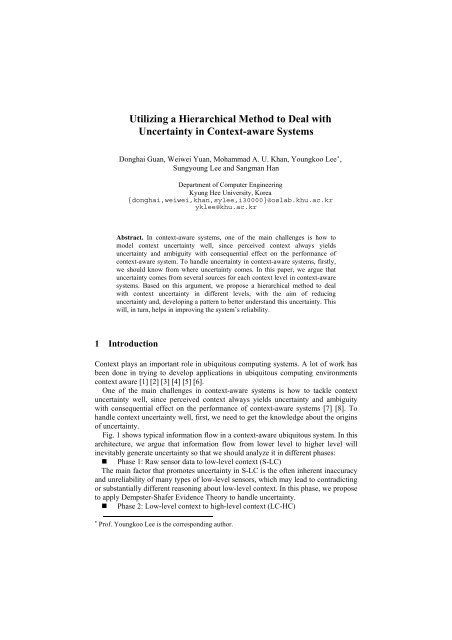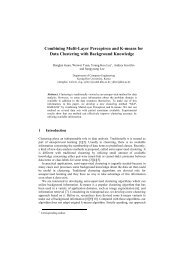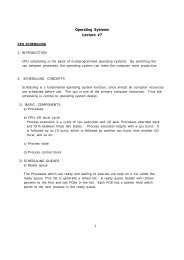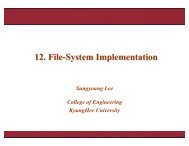Lecture Notes in Computer Science: - Ubiquitous Computing ...
Lecture Notes in Computer Science: - Ubiquitous Computing ...
Lecture Notes in Computer Science: - Ubiquitous Computing ...
Create successful ePaper yourself
Turn your PDF publications into a flip-book with our unique Google optimized e-Paper software.
Utiliz<strong>in</strong>g a Hierarchical Method to Deal with<br />
Uncerta<strong>in</strong>ty <strong>in</strong> Context-aware Systems<br />
Donghai Guan, Weiwei Yuan, Mohammad A. U. Khan, Youngkoo Lee * ,<br />
Sungyoung Lee and Sangman Han<br />
Department of <strong>Computer</strong> Eng<strong>in</strong>eer<strong>in</strong>g<br />
Kyung Hee University, Korea<br />
{donghai,weiwei,khan,sylee,i30000}@oslab.khu.ac.kr<br />
yklee@khu.ac.kr<br />
Abstract. In context-aware systems, one of the ma<strong>in</strong> challenges is how to<br />
model context uncerta<strong>in</strong>ty well, s<strong>in</strong>ce perceived context always yields<br />
uncerta<strong>in</strong>ty and ambiguity with consequential effect on the performance of<br />
context-aware system. To handle uncerta<strong>in</strong>ty <strong>in</strong> context-aware systems, firstly,<br />
we should know from where uncerta<strong>in</strong>ty comes. In this paper, we argue that<br />
uncerta<strong>in</strong>ty comes from several sources for each context level <strong>in</strong> context-aware<br />
systems. Based on this argument, we propose a hierarchical method to deal<br />
with context uncerta<strong>in</strong>ty <strong>in</strong> different levels, with the aim of reduc<strong>in</strong>g<br />
uncerta<strong>in</strong>ty and, develop<strong>in</strong>g a pattern to better understand this uncerta<strong>in</strong>ty. This<br />
will, <strong>in</strong> turn, helps <strong>in</strong> improv<strong>in</strong>g the system’s reliability.<br />
1 Introduction<br />
Context plays an important role <strong>in</strong> ubiquitous comput<strong>in</strong>g systems. A lot of work has<br />
been done <strong>in</strong> try<strong>in</strong>g to develop applications <strong>in</strong> ubiquitous comput<strong>in</strong>g environments<br />
context aware [1] [2] [3] [4] [5] [6].<br />
One of the ma<strong>in</strong> challenges <strong>in</strong> context-aware systems is how to tackle context<br />
uncerta<strong>in</strong>ty well, s<strong>in</strong>ce perceived context always yields uncerta<strong>in</strong>ty and ambiguity<br />
with consequential effect on the performance of context-aware systems [7] [8]. To<br />
handle context uncerta<strong>in</strong>ty well, first, we need to get the knowledge about the orig<strong>in</strong>s<br />
of uncerta<strong>in</strong>ty.<br />
Fig. 1 shows typical <strong>in</strong>formation flow <strong>in</strong> a context-aware ubiquitous system. In this<br />
architecture, we argue that <strong>in</strong>formation flow from lower level to higher level will<br />
<strong>in</strong>evitably generate uncerta<strong>in</strong>ty so that we should analyze it <strong>in</strong> different phases:<br />
• Phase 1: Raw sensor data to low-level context (S-LC)<br />
The ma<strong>in</strong> factor that promotes uncerta<strong>in</strong>ty <strong>in</strong> S-LC is the often <strong>in</strong>herent <strong>in</strong>accuracy<br />
and unreliability of many types of low-level sensors, which may lead to contradict<strong>in</strong>g<br />
or substantially different reason<strong>in</strong>g about low-level context. In this phase, we propose<br />
to apply Dempster-Shafer Evidence Theory to handle uncerta<strong>in</strong>ty.<br />
• Phase 2: Low-level context to high-level context (LC-HC)<br />
*<br />
Prof. Youngkoo Lee is the correspond<strong>in</strong>g author.
This phase is always referred to “Context Aggregator” or “Context Synthesizer”. In<br />
this phase, reason<strong>in</strong>g is always <strong>in</strong> the uncerta<strong>in</strong> conditions. In this regard, we propose<br />
to use Bayesian Networks to <strong>in</strong>fer high-level context.<br />
Fig. 1. Information flow <strong>in</strong> context-aware systems<br />
2 S-LC Uncerta<strong>in</strong>ty<br />
Sensor’s <strong>in</strong>herent uncerta<strong>in</strong>ty is the ma<strong>in</strong> source of this phase’s uncerta<strong>in</strong>ty. To<br />
handle this problem, sensor redundancy is usually applied. Sensor redundancy could<br />
improve system’s reliability, however, at the same time, it always generates sensor<br />
competition problem [9]. Sensor competition means the results of sensors<br />
represent<strong>in</strong>g the same measurement are competitive. Let us consider the follow<strong>in</strong>g<br />
scenario:<br />
The sensors here are three RFIDs (A, B and C). The output of each RFID is a<br />
Boolean variable (true or false). True means a user (Bob) is <strong>in</strong> room, while, false<br />
means it isn’t. Suppose the three RFIDs’ outputs are different. Two RFIDs shows that<br />
Bob is room, while, another one shows Bob is not <strong>in</strong> room. This is a typical sensor<br />
competition problem. In the follow<strong>in</strong>g part, we will describe how to solve it.<br />
The authors <strong>in</strong> [10] propose to use high-level and other same-level context to deal<br />
with this problem. However, we argue that it is not always useful. If high-level or<br />
same-level context is not available, this method can not work well. In this paper, we<br />
propose to use mathematical method to solve it.<br />
2.1 Dumpster-Shafer Theory<br />
The advantage of Dempster-Shafer theory is that it can work well even <strong>in</strong> the case of<br />
lack of knowledge of the complete probabilistic model required for other methods<br />
such as Bayesian <strong>in</strong>ference. The Dempster-Shafer theory of evidence represents<br />
uncerta<strong>in</strong>ty <strong>in</strong> the form of belief functions. It is based on two ideas: the idea of<br />
obta<strong>in</strong><strong>in</strong>g degrees of belief for one question from subjective probabilities for a related
question, and Dempster’s rule for comb<strong>in</strong><strong>in</strong>g such degrees of belief when they are<br />
based on <strong>in</strong>dependent items of evidence [11].<br />
Dempster-Shafer theory starts by assum<strong>in</strong>g a universe of discourse, also called a<br />
frame of discernment, which is a set of mutually exclusive alternatives (similar to a<br />
state space <strong>in</strong> probability), denoted by Ω . Any hypothesis A will refer to a subset of<br />
Ω for which observers can present evidence. The set of all possible subsets of Ω ,<br />
<strong>in</strong>clud<strong>in</strong>g itself and the null set∅ , is called a power set and designated as 2 Ω . Thus,<br />
the power set consists of all possible hypothesis 2 Ω ={ A1<br />
, Ω , A n<br />
}.<br />
We can assign hypothesis to any of the three types of values. Basic probability<br />
numbers are a mapp<strong>in</strong>g of each hypothesis A to a value m(A) between 0 and 1, such<br />
that<br />
• the basic probability number of the null set ∅ is m( ∅ ) =0, and<br />
• the sum mA (<br />
1)<br />
+ … + mA ( n<br />
) =1.<br />
The second type of assignment is a belief function that maps each hypothesis B to a<br />
value bel(B), between 0 and 1, def<strong>in</strong>e as<br />
bel( B) = ∑ m( A ).<br />
(1)<br />
jA : j ⊂B<br />
j<br />
The belief function represents the weight of evidence support<strong>in</strong>g B’s provability.<br />
The third type of assignment is a plausibility function that maps each hypothesis B<br />
to a value pls(B) between 0 and 1, def<strong>in</strong>ed as<br />
pls( B) = ∑ m( A ).<br />
(2)<br />
jA : j ∩B≠∅<br />
j<br />
The plausibility function is the weight of evidence that doesn’t refute B, and belief<br />
and plausibility are related by<br />
pls( B) = 1 − bel( B),<br />
(3)<br />
Where B is the hypothesis “not B”. Shafer showed that a one-to-one<br />
correspondence exists between basic probability numbers, belief, and plausibility,<br />
mean<strong>in</strong>g that any of the three functions is sufficient for deriv<strong>in</strong>g the other two.<br />
Dempster’s Rule for comb<strong>in</strong>ation is a procedure for comb<strong>in</strong><strong>in</strong>g <strong>in</strong>dependent pieces<br />
of evidence. Suppose m ( A)<br />
and m ( A)<br />
1 2<br />
are the basic probability numbers from<br />
two <strong>in</strong>dependent observers. Dempster’s rule for comb<strong>in</strong>ation consists of the<br />
orthogonal sum<br />
∑ m1( Ai) m2( Aj)<br />
i, j:<br />
Ai∩ Aj=<br />
B<br />
mB ( ) = m1( B) ⊕ m2( B) =<br />
.<br />
(4)<br />
m ( A) m ( A )<br />
∑<br />
i, j:<br />
Ai∩ Aj=∅<br />
1 i 2<br />
We can comb<strong>in</strong>e more than two belief functions pairwise <strong>in</strong> any order.<br />
j
2.2 Us<strong>in</strong>g Dempster-Shafer theory <strong>in</strong> our scenario<br />
In our scenario, Ω= { TT , } , where T means Bob is <strong>in</strong> room, and T is the<br />
compliment event mean<strong>in</strong>g Bob is not <strong>in</strong> the room. For this Ω , the power set has<br />
three elements: hypothesis H={T} that Bob is <strong>in</strong> room; hypothesis H={T } that Bob<br />
is not; and hypothesis U= Ω that Bob is <strong>in</strong> room or not. Suppose the probability of<br />
RFID A be<strong>in</strong>g trustworthy isα . If RFID A claims that Bob is <strong>in</strong> room, then its basic<br />
probability assignment will be<br />
m ( H)<br />
= α m ( H ) = 0 m ( U)<br />
= 1−<br />
α<br />
1 1 1 (5)<br />
If RFID A claims that Bob <strong>in</strong> not <strong>in</strong> room, its basic probability assignment will be<br />
m ( H ) = 0 m ( H)<br />
= α m ( U)<br />
= 1−<br />
α<br />
1 1 1 (6)<br />
Likewise, given prior probabilities for the trustworth<strong>in</strong>ess of RFID B and C, we<br />
would construct their basic probability assignments and m similarly.<br />
Next, the comb<strong>in</strong>ed belief of A, B, and C <strong>in</strong> H is<br />
bel( H ) = m( H ) = m ( H ) ⊕m ( H ) ⊕ m ( H )<br />
1 2 3<br />
m2<br />
3<br />
Follow<strong>in</strong>g Dempster’s rule for comb<strong>in</strong>ation (Equation 4), We can compute this by<br />
comb<strong>in</strong><strong>in</strong>g any pair of arguments and then comb<strong>in</strong><strong>in</strong>g the result with the rema<strong>in</strong><strong>in</strong>g<br />
third argument. For example, let’s first comb<strong>in</strong>e m1<br />
and m2<br />
:<br />
1<br />
m1( H) ⊕ m2( H) = [ m1( H) m2( H) + m1( H) m2( U) + m1( U) m2( H)<br />
]<br />
K<br />
1<br />
m1( H) ⊕ m2( H) = [ m1( H) m2( H) + m1( H) m2( U) + m1( U) m2( H)<br />
]<br />
K<br />
1<br />
m1( U) ⊕ m2( U) = m1( U) m2( U)<br />
(7)<br />
K<br />
Where<br />
K = m1( H) m2( H) + m1( H) m2( U) + m1( U) m2( H)<br />
+<br />
(8)<br />
m1( H) m2( H) + m1( H) m2( U) + m1( U) m2( H) + m1( U) m2( U)<br />
We can similarly comb<strong>in</strong>e the result from Equation 7 with m 3<br />
.<br />
To use Dempster-Shafer theory, A, B and C’s reliability must be known. We<br />
calculate <strong>in</strong>itial reliability of each sensor by keep<strong>in</strong>g a malcount for each of them and<br />
then compar<strong>in</strong>g the malcounts to a set of thresholds; a malcount exceed<strong>in</strong>g higher<br />
thresholds lowers the sensor’s reliability rat<strong>in</strong>g.<br />
3 LC-HC Uncerta<strong>in</strong>ty<br />
In our paper, we propose to use Bayesian networks. Bayesian networks are a<br />
powerful way of handl<strong>in</strong>g uncerta<strong>in</strong>ty <strong>in</strong> reason<strong>in</strong>g. A Bayesian network is a directed
acyclic graph of nodes. Nodes represent variables and arcs represent<strong>in</strong>g dependence<br />
relations among variables. For example, if there is an arc from node A to another<br />
node B, then A is a parent of B. In Bayesian networks, for each node, the conditional<br />
probability on its parent-set is stored. These locally stored probabilities can be<br />
comb<strong>in</strong>ed us<strong>in</strong>g the cha<strong>in</strong> rule [12] to construct the overall jo<strong>in</strong>t probability<br />
distribution P.<br />
Two ma<strong>in</strong> merits of Bayesian networks drive us to adopt it.<br />
One is that Bayesian networks can handle <strong>in</strong>complete data sets. This po<strong>in</strong>t is very<br />
important as context-aware system is always partially-observable. The other one is<br />
that us<strong>in</strong>g Bayesian networks, we can learn causal relationships between low-level<br />
context and high-level context. So if only one or two k<strong>in</strong>ds of low-level are available,<br />
we can select the most important one by causal relationships so as to improve<br />
reason<strong>in</strong>g accuracy.<br />
Let’s see an example of Bayesian network. Consider<strong>in</strong>g the case <strong>in</strong> which the<br />
system needs to <strong>in</strong>fer whether the user is hav<strong>in</strong>g lunch or not. For <strong>in</strong>ferr<strong>in</strong>g such an<br />
activity it is needed that we have some data about the location of the user, time of the<br />
day, and some data about his actions.. Through prior knowledge, we may construct a<br />
Bayesian network shown <strong>in</strong> Fig. 2. Then activity can be deduced from this network.<br />
Fig.2. Bayesian network for activity reason<strong>in</strong>g<br />
4 Conclusions and Future Work<br />
In this paper, we propose a hierarchical method to deal with uncerta<strong>in</strong>ty <strong>in</strong> contextaware<br />
systems. Two different methods: Dempster-Shafer Theory and Bayesian<br />
Networks are applied <strong>in</strong> two different phases <strong>in</strong> our paper. We argue that this<br />
hierarchical method is feasible from the viewpo<strong>in</strong>t of mathematical model. However,<br />
when us<strong>in</strong>g mathematical methods <strong>in</strong> real applications, many other aspects, such as<br />
hardware feasibility, time delay etc. should also be considered. The <strong>in</strong>volve matter of<br />
these aspects <strong>in</strong> our current model is a topic of our future research. We are currently<br />
study<strong>in</strong>g the application of different approaches on our test bed—CAMUS [13] and<br />
compar<strong>in</strong>g their performance.
Acknowledgement<br />
The research was supported by the Driv<strong>in</strong>g Force Project for the Next Generation of<br />
Gyeonggi Prov<strong>in</strong>cial Government <strong>in</strong> Republic of Korea.<br />
References<br />
1. A.n<strong>in</strong>d K. Dey and Gregory D. Abowd: Towards a better understand<strong>in</strong>g of context and<br />
context-awareness. In Proc. of the 2000 Conference on Human Factors <strong>in</strong> Comput<strong>in</strong>g<br />
Systems, Netherlands (2000) 304-307<br />
2. An<strong>in</strong>d K. Dey, Daniel Salber and Gregory D. Abowd: A Conceptual Framework and a<br />
Toolkit for Support<strong>in</strong>g the Rapid Prototyp<strong>in</strong>g of Context-Aware Applications. In J.<br />
Human-<strong>Computer</strong> Interaction (HCI) Journal, London, UK (2001) 97-166<br />
3. Jason I. Hong and James A. Landay: An Infrastructure Approach to Context-Aware<br />
Comput<strong>in</strong>g. In J. Human-<strong>Computer</strong> Interaction (HCI), London, UK (2001) 287-303<br />
4. Steven AN Shafer, Barry Brumitt and JJ Cadiz: Interaction Issues <strong>in</strong> Context-Aware<br />
Interactive Environments. In J. Human-<strong>Computer</strong> Interaction (HCI), London, UK (2001)<br />
363-378<br />
5. Pascoe, J., et al.: Issues <strong>in</strong> Develop<strong>in</strong>g Context-Aware Comput<strong>in</strong>g. In Proc. of the<br />
International Symposium on Handheld and <strong>Ubiquitous</strong> Comput<strong>in</strong>g. Spr<strong>in</strong>ger-Verlag,<br />
Heidelberg, Germany (1999) 208-221<br />
6. Schilit, W. N.: A Context-Aware System Architecture for Mobile Distributed Comput<strong>in</strong>g.<br />
PhD Thesis. Columbia University (1995)<br />
7. Satyanarayanan M.: Pervasive Comput<strong>in</strong>g: Vision and Challenges. In IEEE Proc. of IEEE<br />
Personal Communications, (2001) 10-17<br />
8. Satyanarayanan M.: Cop<strong>in</strong>g with Uncerta<strong>in</strong>ty. In J. of IEEE Pervasive Comput<strong>in</strong>g, (2003)<br />
2-3<br />
9. Wilfried Elmenreich: Sensor Fusion <strong>in</strong> Time-Triggered Systems. Ph. D. dissertation,<br />
Vienna University of Technology (2002)<br />
10. Padovitz A., Loke S. W., Zaslavsky A.: On Uncerta<strong>in</strong>ty <strong>in</strong> Context-Aware Comput<strong>in</strong>g:<br />
Appeal<strong>in</strong>g to High-Level and Same-Level Context for Low-Level Context Verification.<br />
In Proc. of International Workshop on <strong>Ubiquitous</strong> Comput<strong>in</strong>g, 6th International<br />
Conference on Enterprise Information Systems (ICEIS) , Portugal, (2004) 62 – 72<br />
11. Shafer, Glenn and Judea Pearl: Read<strong>in</strong>gs <strong>in</strong> Uncerta<strong>in</strong> Reason<strong>in</strong>g. Morgan Kaufmann (1990)<br />
12. Jensen, F.V.: Introduction to Bayesian Networks. University College London Press, (1998)<br />
13. Hung, N.Q., Shehzad, A., Kiani, S. L., Riaz, M., Lee, S.: A Unified Middleware<br />
Framework for Context Aware <strong>Ubiquitous</strong> Comput<strong>in</strong>g. In the 2004 IFIP International<br />
Conference on Embedded And <strong>Ubiquitous</strong> Comput<strong>in</strong>g , EUC2004, Japan (2004) 672-681










